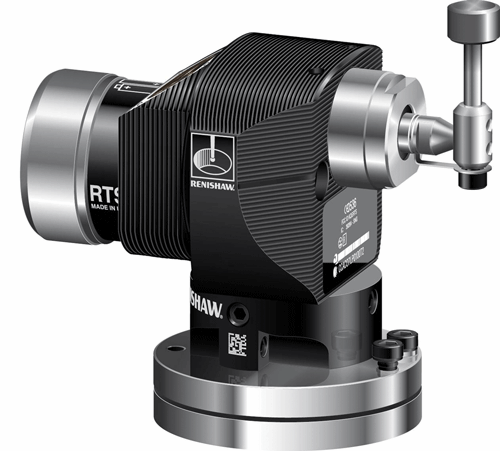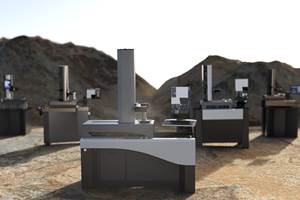Multiple Tool Setting and Inspection Probing
A fine line often exists in the decision of when to invest in additional capital equipment and/or personnel to handle overloaded machines or a backlog of customer requests.
A fine line often exists in the decision of when to invest in additional capital equipment and/or personnel to handle overloaded machines or a backlog of customer requests. If a shop is pushing its limits to meet customer demands, it may need to rely on subcontract help. If delivery times allow, adding new equipment may be an option, but such a significant expense needs to be justified beyond a single job. And new shopfloor personnel generally require at least some training, not to mention what can often be a drawn out hiring process.
Another solution to this issue (which makes sense to apply even before facing a time or commodity crunch) is to streamline the production process, increasing throughput from the existing assets. Such an exercise can help to defer capital expenditures, reduce subcontract and overtime bills and perhaps even free up enough machine time to pursue additional business.
Reduced Downtime
One method of improving the process might be to eliminate the manual setting of workpiece positions and inspection of finished product. Probing systems such as those from Renishaw can eliminate costly machine downtime and the scrapping of components associated with manual setting and inspection.
Renishaw’s RMI-Q multiple-probe radio transmission system uses a single radio receiver for tool setting probe- and spindle-mounted touch probe installations, offering fast integration and a cable-free machine environment. The system is easily integrated on a range of machining centers and CNC milling machines, offering users automated on-machine tool setting, tool breakage detection, part setup and part verification capability.
To take full advantage of the radio transmission interface, as many as four separate radio transmission probes can be operated on the same CNC machine. This capability makes it a good fit for CNC machining centers or machines with rotary tables or twin pallets.
A number of different multiple probing configurations are possible, typically including the Renishaw RTS tool setter with a Renishaw RMP60 inspection probe or other compatible spindle-mounted touch probes with radio transmission (such as the RMP40 or RMP600), selected to suit the user’s specific application requirements.
The RMI-Q is used to activate either the spindle-mounted touch probe or table-mounted tool setting probe and gives visual indication of the activated device. Designed to be compliant with radio regulations worldwide, it features a 2.4-GHz frequency-hopping spread spectrum (FHSS) radio transmission enabling uninterrupted operation in increasingly busy radio environments. The system is suitable for applications that have obscured line-of-sight to the probe, and its transmission range of as much as 15 meters makes it particularly suitable for use on large machines. The RMI-Q has all the functionality of Renishaw’s RMI, combined with additional features. RMI-Q allows easy acquisition using a simple macro to partner all required probes to the interface in a single operation. Additionally, when RMI-Q is used in conjunction with an RTS and radio spindle probe, a simple automated calibration cycle can be run using the RTS stylus as the calibration artifact.
The RTS tool setting probe with radio transmission is a robust, compact and cable-free product that does not restrict table movement. The contact tool setter offers users broken tool detection combined with fast and accurate tool measurement. It can measure both tool length and diameter of milling cutters, twist drills and end mills. The design is particularly suitable for machines with twin pallets or rotary tables, which historically have proven challenging for installations of hard-wired tool setters. It is powered by two standard AA batteries.
Maximized Benefits
Although shops commonly limit their probing activity to simple job setup activities, it can be used effectively throughout the manufacturing cycle. Probing can provide in-depth information about the production process that may otherwise be missed. Analyzing and reacting to this information allows a machine tool to automatically adapt throughout the cutting process, reducing operator
intervention and increasing the likelihood of producing accurate components.
Finished components can be inspected on the same machine used to produce them, with reports on their dimensional accuracy, and information on any updates applied during machining can be produced automatically.
Renishaw offers a range of probing solutions for inspection and tool setting, as well as related software. The products can be used for such applications as part or tool identification, intelligent program selection, clearance checking, cutting path optimization, adaptive machining, and tool condition monitoring.
Related Content
PMTS 2023 Product Preview: Measurement
Learn about some of the latest measurement solutions that will be on display at PMTS 2023.
Read MorePrecision Machining Technology Review: December 2023
Production Machining’s December 2023 technology showcase includes some of the latest technology from Sandvik Coromant, Nikon Metrology, The L.S. Starrett Co., Walter USA, Kennametal and SolidCAM.
Read MoreKeeping Watch on Small Parts
From watch parts to exotic medical applications, this shop takes on the world of micromachining.
Read MoreIn-Machine Probing Possibilities for VTLs
A manufacturer of vertical turning centers uses a “push/pull” optoelectronic probe with custom bracket to enable its machines to perform effective, in-process measurement of shafts and related automotive components.
Read MoreRead Next
Probing for Quality
Committed employee owners are the foundation of this company’s achievements in high precision manufacturing.
Read MoreThe Value of Swiss-Types Milling Rectangular Medical Parts
High-speed spindle technology was key to effective milling of small cardiac monitoring components complete on a CNC sliding-headstock machine platform instead of running them across two mills.
Read MoreAvoid the 7 Deadly Sins of Manufacturing
Identifying and preventing these manufacturing sins will reduce or eliminate unnecessary waste, improve efficiency and productivity as well as protect profitability and cash flow.
Read More
























